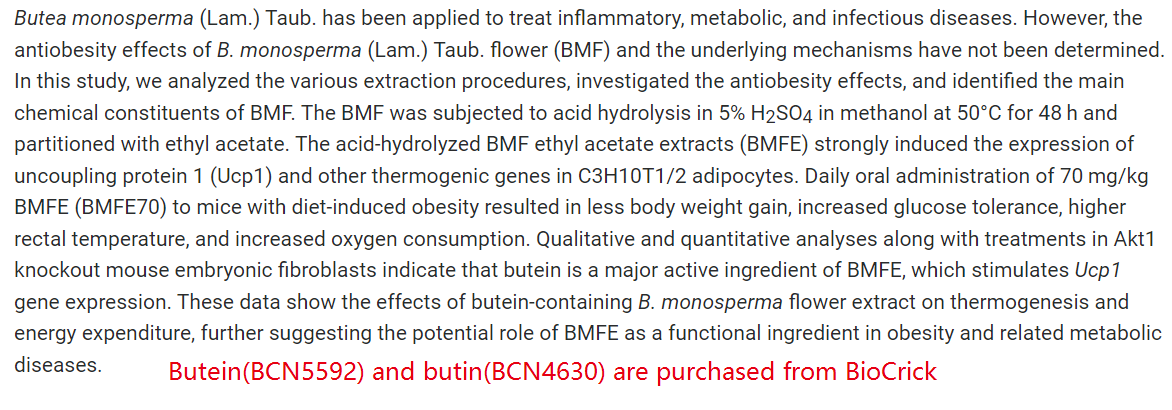Butein-Enriched Fractions of Butea monosperma (Lam.) Taub. Flower Decrease Weight Gains and Increase Energy Expenditure in High-Fat Diet-Induced Obese Mice
Journal of Medicinal Food 30 Nov 2021
PMID:34847724
 Butea monosperma (Lam.) Taub. has been applied to treat inflammatory, metabolic, and infectious diseases. However, the antiobesity effects of B. monosperma (Lam.) Taub. flower (BMF) and the underlying mechanisms have not been determined. In this study, we analyzed the various extraction procedures, investigated the antiobesity effects, and identified the main chemical constituents of BMF. The BMF was subjected to acid hydrolysis in 5% H2SO4 in methanol at 50°C for 48 h and partitioned with ethyl acetate. The acid-hydrolyzed BMF ethyl acetate extracts (BMFE) strongly induced the expression of uncoupling protein 1 (Ucp1) and other thermogenic genes in C3H10T1/2 adipocytes. Daily oral administration of 70 mg/kg BMFE (BMFE70) to mice with diet-induced obesity resulted in less body weight gain, increased glucose tolerance, higher rectal temperature, and increased oxygen consumption. Qualitative and quantitative analyses along with treatments in Akt1 knockout mouse embryonic fibroblasts indicate that butein is a major active ingredient of BMFE, which stimulates Ucp1 gene expression. These data show the effects of butein-containing B. monosperma flower extract on thermogenesis and energy expenditure, further suggesting the potential role of BMFE as a functional ingredient in obesity and related metabolic diseases.
Butea monosperma (Lam.) Taub. has been applied to treat inflammatory, metabolic, and infectious diseases. However, the antiobesity effects of B. monosperma (Lam.) Taub. flower (BMF) and the underlying mechanisms have not been determined. In this study, we analyzed the various extraction procedures, investigated the antiobesity effects, and identified the main chemical constituents of BMF. The BMF was subjected to acid hydrolysis in 5% H2SO4 in methanol at 50°C for 48 h and partitioned with ethyl acetate. The acid-hydrolyzed BMF ethyl acetate extracts (BMFE) strongly induced the expression of uncoupling protein 1 (Ucp1) and other thermogenic genes in C3H10T1/2 adipocytes. Daily oral administration of 70 mg/kg BMFE (BMFE70) to mice with diet-induced obesity resulted in less body weight gain, increased glucose tolerance, higher rectal temperature, and increased oxygen consumption. Qualitative and quantitative analyses along with treatments in Akt1 knockout mouse embryonic fibroblasts indicate that butein is a major active ingredient of BMFE, which stimulates Ucp1 gene expression. These data show the effects of butein-containing B. monosperma flower extract on thermogenesis and energy expenditure, further suggesting the potential role of BMFE as a functional ingredient in obesity and related metabolic diseases.


